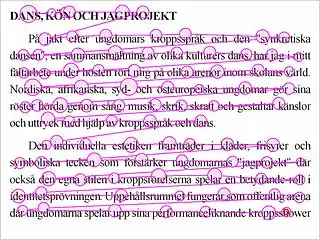眼动追踪
眼动追踪,(英語:),是指通过测量眼睛的注视点的位置或者眼球相对头部的运动而实现对眼球运动的追踪。眼动仪是一种能够跟踪测量眼球位置及眼球运动信息的一种设备,在视觉系统、心理学、认知语言学的研究中有广泛的应用。目前眼动追踪有多种方法,其中最常用的无创手段是通过视频拍摄设备来获取眼睛的位置。有创的手段包括在眼睛中埋置眼动测定线圈或者使用微电极描记眼动电图。
研究历史
在19世纪,眼动的研究主要是靠直接对眼睛进行观察完成的。
1879年,法国巴黎的眼科医生賈馮(Louis Émile Javal)发现人们在阅读文字的时候,眼睛的注视点并不是平滑的划过所注视的文字,而是在某一点停留一段时间(注视),然后进行一词快速眼动切换[1] 。人们根据这项发现提出了关于文字阅读的许多被认为重要的问题:人们的眼睛遇到哪些单词会停下来?会在这些单词上停留多长时间?眼睛什么时候会回顾前面已经看到过的单词?这些问题在 20 世纪得到了广泛的研究。

埃德蒙·休伊(Edmund Huey)[2]使用带有人工瞳孔的接触镜制造出了最早的眼动仪。休伊定量研究了眼睛的回顾现象(回顾现象在快速眼动中所占的比例很小),他发现人们在阅读的时候,有些单词根本就没有被注视过。
第一台非侵入式的眼动仪是巴斯韋爾(Guy Thomas Buswell)在芝加哥发明的。这台眼动仪的原理是,将一束光打到眼睛表面,然后使用胶卷记录从眼睛反射回来的光,据此分析眼睛注视点的位置。巴斯韋爾对人们进行文字阅读[3]和浏览照片[4]时的眼动状况做了系统的研究。
1950 年,阿尔弗雷德·雅布斯[5]在眼动研究方面作出了许多被认为重要的工作,他在1967年出版的一本书也被广泛引用。他发现给被试者的分配的任务目标很大程度上决定了被试者的眼动轨迹。在他的著作中,他这样描述眼睛的注视点与人们的注视兴趣:
- 「所有的记录..都表明眼動的特徴几乎是完全独立的。只要打印在平面或是接近平面的材質上,頂多只會輕微的受到該材質的影響[6]」。觀察圖形時,眼動的週期「不只是在圖形上看到了什麼,更包括觀察者遭遇問題時,期望在圖形上找出更多資訊的情境[7]」。
- 「眼動的記錄顯示,觀察者通常將注意力集中在圖形上的特定元素...眼睛的移動反映了人們的思考過程;因此,側錄觀察者的眼睛移動,可以一個程度的了解觀察者在想什麼。記錄是什麼東西吸引了觀察者的注意是很容易的事(因此,也能知道觀察者在想什麼),記錄其順序、頻率也非常容易[6]」。
- 「觀察者的注意力經常望向一些不重要的事物,但對觀察者本身而言可能很重要。觀察者在某些情境下經常將注意力放在一些不尋常的元素上,比如不熟悉時、不完全理解時...[8]」。
- 「...當觀察者改變注視的點時,觀察者仍會不斷的來回注視。觀察者的知覺並不會用在第二個注視的元素上,而會反覆思索對觀察者而言最動要的元素[9]」。
应用
另外参见
- 注意力追踪
- 眼动
- 阅读文字时的眼动
- 阅读乐谱时的眼动
- 中央凹
- Gaze-contingency paradigm
- 周边视野
- Foveated imaging
- 眼动追踪仪
参考文献
- 见 Huey 在1908/1968 的报道.
- Huey, Edmund. . MIT Press 1968 (originally published 1908).
- Buswell (1922, 1937)
- Buswell (1935)
- Yarbus (1967)
- Yarbus 1967,第190页
- Yarbus 1967,第194页
- Yarbus 1967,第191页
- Yarbus 1967,第193页
- Hunziker, H. W. (1970). Visuelle Informationsaufnahme und Intelligenz: Eine Untersuchung über die Augenfixationen beim Problemlösen. Schweizerische Zeitschrift für Psychologie und ihre Anwendungen, 1970, 29, Nr 1/2 (english abstract: http://www.learning-systems.ch/multimedia/forsch1e.htm )
- http://www.learning-systems.ch/multimedia/eye%20movements%20problem%20solving.swf
- http://www.learning-systems.ch/multimedia/forsch1e.htm
扩展阅读
- Adler FH & Fliegelman (1934). Influence of fixation on the visual acuity. Arch. Ophthalmology 12, 475.
- Buswell, G.T. (1922). Fundamental reading habits: A study of their development. Chicago, IL: University of Chicago Press.
- Buswell G.T. (1935). How People Look at Pictures. Chicago: Univ. Chicago Press 137–55. Hillsdale, NJ: Erlbaum
- Buswell, G.T. (1937). How adults read. Chicago, IL: University of Chicago Press.
- Carpenter, Roger H.S.; Movements of the Eyes (2nd ed.). Pion Ltd, London, 1988. ISBN 0-85086-109-8.
- Cornsweet TN, Crane HD. (1973) Accurate two-dimensional eye tracker using first and fourth Purkinje images. J Opt Soc Am. 63, 921–8.
- Cornsweet TN. (1958). New technique for the measurement of small eye movements. JOSA 48, 808–811.
- Deubel, H. & Schneider, W.X. (1996) Saccade target selection and object recognition: Evidence for a common attentional mechanism. Vision Research, 36, 1827–1837.
- Duchowski, A. T., "A Breadth-First Survey of Eye Tracking Applications", Behavior Research Methods, Instruments, & Computers (BRMIC), 34(4), November 2002, pp. 455–470.
- Eizenman M, Hallett PE, Frecker RC. (1985). Power spectra for ocular drift and tremor. Vision Res. 25, 1635–40
- Ferguson RD (1998). Servo tracking system utilizing phase-sensitive detection of reflectance variations. US Patent # 5,767,941
- Hammer DX, Ferguson RD, Magill JC, White MA, Elsner AE, Webb RH. (2003) Compact scanning laser ophthalmoscope with high-speed retinal tracker. Appl Opt. 42, 4621–32.
- Hoffman, J. E. (1998). Visual attention and eye movements. In H. Pashler (ed.), Attention (pp. 119–154). Hove, UK: Psychology Press.
- Holsanova, J. (forthcoming) Picture viewing and picture descriptions, Benjamins.
- Huey, E.B. (1968). The psychology and pedagogy of reading. Cambridge, MA: MIT Press. (Originally published 1908)
- Jacob, R. J. K. & Karn, K. S. (2003). Eye Tracking in Human-Computer Interaction and Usability Research: Ready to Deliver the Promises. In R. Radach, J. Hyona, & H. Deubel (eds.), The mind's eye: cognitive and applied aspects of eye movement research (pp. 573–605). Boston: North-Holland/Elsevier.
- Just MA, Carpenter PA (1980) A theory of reading: from eye fixation to comprehension. Psychol Rev 87:329–354
- Liechty,J, Pieters, R, & Wedel, M. (2003). The Representation of Local and Global Exploration Modes in Eye Movements through Bayesian Hidden Markov Models. Psychometrika, 68 (4), 519–542.
- Mulligan, JB, (1997). Recovery of Motion Parameters from Distortions in Scanned Images. Proceedings of the NASA Image Registration Workshop (IRW97), NASA Goddard Space Flight Center, MD
- Ott D & Daunicht WJ (1992). Eye movement measurement with the scanning laser ophthalmoscope. Clin. Vision Sci. 7, 551–556.
- Posner, M. I. (1980) Orienting of attention. Quarterly Journal of Experimental Psychology 32: 3–25.
- Rayner, K. (1978). Eye movements in reading and information processing. Psychological Bulletin, 85, 618–660
- Rayner, K. (1998) Eye movements in reading and information processing: 20 years of research. Psychological Bulletin, 124, 372–422.
- Riggs LA, Armington JC & Ratliff F. (1954) Motions of the retinal image during fixation. JOSA 44, 315–321.
- Riggs, L. A. & Niehl, E. W. (1960). Eye movements recorded during convergence and divergence. J Opt Soc Am 50:913–920.
- Riju Srimal, Jorn Diedrichsen, Edward B. Ryklin, and Clayton E. Curtis. Obligatory adaptation of saccade gains. J Neurophysiol. 2008 Mar;99(3):1554-8
- Robinson, D. A. A method of measuring eye movement using a scleral search coil in a magnetic field. IEEE Trans. Biomed. Eng., vol. BME-l0, pp. 137–145, 1963
- Wright, R.D., & Ward, L.M. (2008). Orienting of Attention. New York. Oxford University Press.
- Yarbus, A. L. Eye Movements and Vision. Plenum. New York. 1967 (Originally published in Russian 1962)
商业化眼动追踪仪
- Bojko, A. (2006). Using Eye Tracking to Compare Web Page Designs: A Case Study. Journal of Usability Studies, Vol.1, No. 3.
- Bojko, A. & Stephenson, A. (2005). It's All in the Eye of the User: How eye tracking can help answer usability questions. User Experience, Vol. 4, No. 1.
- Chandon, Pierre, J. Wesley Hutchinson, and Scott H. Young (2001), Measuring Value of Point-of-Purchase Marketing with Commercial Eye-Tracking Data.
- Duchowski, A. T., (2002) A Breadth-First Survey of Eye Tracking Applications, 'Behavior Research Methods, Instruments, & Computers (BRMIC),' 34(4), November 2002, pp. 455–470.
- National Highway Traffic Safety Administration. (n.d.) Retrieved July 9, 2006, from
- Pieters, R., Wedel, M. & Zhang, J. (2007). Optimal Feature Advertising Under Competitive Clutter, Management Science, 2007, 51 (11) 1815–1828.
- Pieters, R., & Wedel, M. (2007). Goal Control of Visual Attention to Advertising: The Yarbus Implication, Journal of Consumer Research, 2007, 34 (August), 224–233.
- Pieters, R. & Wedel, M. (2004). Attention Capture and Transfer by elements of Advertisements. Journal of Marketing, 68 (2), 2004, 36–50.
- Thomas RECORDING GmbH, high-speed Eye Tracking Systems for neuro-scientific purposes
- Weatherhead, James. (2005) Eye on the Future, 'British Computer Society, ITNOW Future of Computing,' 47 (6), pp. 32–33
- Wedel, M. & Pieters, R. (2000). Eye fixations on advertisements and memory for brands: a model and findings. Marketing Science, 19 (4), 2000, 297–312.
- Wittenstein, Jerran. (2006). EyeTracking sees gold in its technology. [Electronic Version]. San Diego Source, The Daily Transcript, April, 3rd, 2006.
